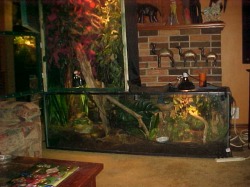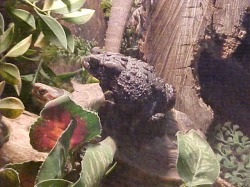PLEASE NOTE
The information on the BambooZoo site is as much as 10 years old and in the hobby much has been learned. Though, I believe there is merit in keeping the site open. There are many controversial issues presented in these pages. Please view BambooZoo as a starting point in your research.
These beings are as complicated as we are and deserve more than a basic 5 paragraph care sheet to maintain their health and well being.
My passions have evolved. This is is the site I am growing today. We Heal the World
The information on the BambooZoo site is as much as 10 years old and in the hobby much has been learned. Though, I believe there is merit in keeping the site open. There are many controversial issues presented in these pages. Please view BambooZoo as a starting point in your research.
These beings are as complicated as we are and deserve more than a basic 5 paragraph care sheet to maintain their health and well being.
My passions have evolved. This is is the site I am growing today. We Heal the World
The Natural History and Captive Care of the Frilled Dragon or Frillneck Lizard, Chlamydosaurus kingii – Part I, Frilled Dragons in the Wild
Written by: Frank Indiviglio
ThatReptileBlog
ThatReptileBlog
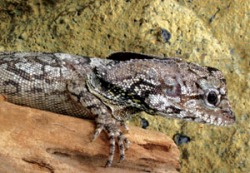
Overview
The frilled dragon was a creature of legend to budding American herpetologists growing up in the 60’s and 70’s – we devoured what little published information existed, but seeing one alive was out of the question, short of a trip to its habitat. It is still hard for me to imagine that, as a Bronx Zoo reptile keeper, I acquired my first 2 individuals a mere 15 or so years ago (at $1,500 each!). Today these magnificent lizards are commercially bred in large numbers – both on “farms” in Indonesia and by herptoculturists worldwide.
Although not an “easy” species, and certainly one requiring a good deal of space, frilled dragons are among the most rewarding lizards to keep, and will provide you with a lifetime of interest and enjoyment. This week we’ll take a look at their natural history, so that we can better understand how to provide for these fascinating animals in captivity.
Physical Description
The body color ranges from grayish through orange-brown to nearly black, often with dark variegations along the sides, and usually matches the color of local tree trunks. The inner surface of the frill (the large skin fold about the neck) is shaded in yellow, black, orange and/or red. The hind legs are powerfully built. Males can reach 38 inches in length; females are somewhat smaller.
The neck frill is supported by cartilaginous rods and is connected to muscles in the tongue and jaw. It expands when the lizard gapes its jaws and is used to intimidate predators and rivals, and in courtship displays. Frilled dragons are one of the few lizards to use bipedal locomotion – they flee predators by rising up and running off on their rear legs.
Range and Habitat
Frilled dragons are found in northern Australia and southern New Guinea. They frequent open tropical and warm temperate forest and wooded scrub land.
Largely arboreal, they dwell in the forest canopy during the dry season. During this period the lizards reduce their food and water consumption, metabolic rate and body temperature. The rainy season is largely spent on tree trunks within 4-15 feet of the ground.
In northern Australia and other parts of the range, frilled lizard habitat is subjected to frequent fires (natural and human induced, as a component of habitat management) during the dry season. Field research has revealed that the lizards escape the fires by re-locating to the highest branches of large Eucalyptus trees. Interestingly, it was also found that a number of individuals descend to the ground and shelter in abandoned termite nests during fires – a most unusual (and, it would seem, learned) behavior for an arboreal lizard.
Status in the Wild
Populations appear stable; protected by the Australian government.
Diet
Caterpillars, scorpions, ants, termites, beetles, spiders and other invertebrates, small lizards and snakes; nestling birds and small mammals are taken on rare occasions.
Frilled dragons seem to occupy a unique feeding niche within a lizard-rich habitat. Although largely arboreal, they feed on the ground by dropping from their tree-trunk perches to intercept passing insects and small animals.
Research has shown that, immediately after dry season fires, the percentage of large invertebrates in the frilled dragons’ diets increases significantly. It seems that the lizards are able to see larger prey animals more easily once the ground cover has been burned off. So strong is this effect that lizards living in unburned areas move into the burned areas as soon as the fires have subsided.
Reproduction
Males are highly territorial and fight for breeding rights. Both sexes use neck frill displays during courtship and territorial disputes. Mating coincides with the start of the rainy season. Females bury 8-14 eggs in the ground, and may produce 2 clutches each year if food is plentiful. The eggs hatch in approximately 69 days and the young average 2 inches in length. Hatchlings stay in close proximity to each other, possibly as a defense mechanism, for approximately 10 days.
Frilled Dragon Relatives
Frilled dragons are classified within the family Agamidae, which contains over 300 species. Some of its members are among the most common and typical lizards of their habitats, while others have extremely specialized diets, unique adaptations and very restricted ranges. Most hunt beetles, spiders, scorpions and a wide variety of other invertebrates, but the dabb lizards, Uromastyx spp., of North Africa and the Middle East are herbivorous (in captivity they are especially fond of dried split peas!) while Australia’s thorny devil, Moloch horridus, subsists entirely upon ants.
The toad-headed lizards, Phrynocephalus spp. and the pygmy lizards, Cophotis spp. are unique among the Agamids in bearing live young. Toad-headed lizards inhabit the deserts of south and central Asia, and utilize microscopic channels among their scales to funnel dew to the mouth. Southeast Asia’s slow-moving pygmy lizards, likened by some to chameleons, have prehensile tails and dwell in high-altitude moss forests.
Perhaps the most commonly-seen of Africa’s lizards are various species of the genus Agama (commonly known as “agamas”), males of which perch on fences and houses and bob their brightly-colored (often blue) heads in courtship displays. As with most Agamids, their head and body coloration intensifies during the breeding season. Equally conspicuous throughout much of India and Southeast Asia are the various Calotes species, often locally referred to as “garden lizards” due to their propensity to take up residence near people. Australia’s bearded dragon, Pagona vitticeps, is a popular pet, with millions bred yearly by hobbyists to supply the trade.
Among the more unusual Agamids are the 40 or so species of Draco, the “flying lizards”. These supremely adapted aerialists are the only lizards to have developed elongated ribs to assist in gliding (flying geckos, Ptychozoon spp., also glide, but utilize small skin flaps along their sides). The flying lizard’s ribs are covered by loose-fitting, brightly colored skin (the patagium) that, when extended, allows for “flights” of at least 50 feet and for considerable in-air maneuverability. Other unique family members include the cold-tolerant Himalayan agama, A. himalayana, which ranges to 11,000 feet above sea level, and the horned agamas, Ceratophora spp., males of which sport a long, flexible appendage on the tip of their snouts.
We still have a lot to learn about the spectacular frilled dragons – please observe yours closely, and pass along your ideas and questions. I’ll be sure to include them in future articles. Onto captive care next time…. thanks, Frank.
Excellent summaries of two frilled dragon field studies are posted at:
http://www.publish.csiro.au/paper/WR9890491.htm
http://www.environment.gov.au/biodiversity/publications/series/paper3/fire17.html
The frilled dragon was a creature of legend to budding American herpetologists growing up in the 60’s and 70’s – we devoured what little published information existed, but seeing one alive was out of the question, short of a trip to its habitat. It is still hard for me to imagine that, as a Bronx Zoo reptile keeper, I acquired my first 2 individuals a mere 15 or so years ago (at $1,500 each!). Today these magnificent lizards are commercially bred in large numbers – both on “farms” in Indonesia and by herptoculturists worldwide.
Although not an “easy” species, and certainly one requiring a good deal of space, frilled dragons are among the most rewarding lizards to keep, and will provide you with a lifetime of interest and enjoyment. This week we’ll take a look at their natural history, so that we can better understand how to provide for these fascinating animals in captivity.
Physical Description
The body color ranges from grayish through orange-brown to nearly black, often with dark variegations along the sides, and usually matches the color of local tree trunks. The inner surface of the frill (the large skin fold about the neck) is shaded in yellow, black, orange and/or red. The hind legs are powerfully built. Males can reach 38 inches in length; females are somewhat smaller.
The neck frill is supported by cartilaginous rods and is connected to muscles in the tongue and jaw. It expands when the lizard gapes its jaws and is used to intimidate predators and rivals, and in courtship displays. Frilled dragons are one of the few lizards to use bipedal locomotion – they flee predators by rising up and running off on their rear legs.
Range and Habitat
Frilled dragons are found in northern Australia and southern New Guinea. They frequent open tropical and warm temperate forest and wooded scrub land.
Largely arboreal, they dwell in the forest canopy during the dry season. During this period the lizards reduce their food and water consumption, metabolic rate and body temperature. The rainy season is largely spent on tree trunks within 4-15 feet of the ground.
In northern Australia and other parts of the range, frilled lizard habitat is subjected to frequent fires (natural and human induced, as a component of habitat management) during the dry season. Field research has revealed that the lizards escape the fires by re-locating to the highest branches of large Eucalyptus trees. Interestingly, it was also found that a number of individuals descend to the ground and shelter in abandoned termite nests during fires – a most unusual (and, it would seem, learned) behavior for an arboreal lizard.
Status in the Wild
Populations appear stable; protected by the Australian government.
Diet
Caterpillars, scorpions, ants, termites, beetles, spiders and other invertebrates, small lizards and snakes; nestling birds and small mammals are taken on rare occasions.
Frilled dragons seem to occupy a unique feeding niche within a lizard-rich habitat. Although largely arboreal, they feed on the ground by dropping from their tree-trunk perches to intercept passing insects and small animals.
Research has shown that, immediately after dry season fires, the percentage of large invertebrates in the frilled dragons’ diets increases significantly. It seems that the lizards are able to see larger prey animals more easily once the ground cover has been burned off. So strong is this effect that lizards living in unburned areas move into the burned areas as soon as the fires have subsided.
Reproduction
Males are highly territorial and fight for breeding rights. Both sexes use neck frill displays during courtship and territorial disputes. Mating coincides with the start of the rainy season. Females bury 8-14 eggs in the ground, and may produce 2 clutches each year if food is plentiful. The eggs hatch in approximately 69 days and the young average 2 inches in length. Hatchlings stay in close proximity to each other, possibly as a defense mechanism, for approximately 10 days.
Frilled Dragon Relatives
Frilled dragons are classified within the family Agamidae, which contains over 300 species. Some of its members are among the most common and typical lizards of their habitats, while others have extremely specialized diets, unique adaptations and very restricted ranges. Most hunt beetles, spiders, scorpions and a wide variety of other invertebrates, but the dabb lizards, Uromastyx spp., of North Africa and the Middle East are herbivorous (in captivity they are especially fond of dried split peas!) while Australia’s thorny devil, Moloch horridus, subsists entirely upon ants.
The toad-headed lizards, Phrynocephalus spp. and the pygmy lizards, Cophotis spp. are unique among the Agamids in bearing live young. Toad-headed lizards inhabit the deserts of south and central Asia, and utilize microscopic channels among their scales to funnel dew to the mouth. Southeast Asia’s slow-moving pygmy lizards, likened by some to chameleons, have prehensile tails and dwell in high-altitude moss forests.
Perhaps the most commonly-seen of Africa’s lizards are various species of the genus Agama (commonly known as “agamas”), males of which perch on fences and houses and bob their brightly-colored (often blue) heads in courtship displays. As with most Agamids, their head and body coloration intensifies during the breeding season. Equally conspicuous throughout much of India and Southeast Asia are the various Calotes species, often locally referred to as “garden lizards” due to their propensity to take up residence near people. Australia’s bearded dragon, Pagona vitticeps, is a popular pet, with millions bred yearly by hobbyists to supply the trade.
Among the more unusual Agamids are the 40 or so species of Draco, the “flying lizards”. These supremely adapted aerialists are the only lizards to have developed elongated ribs to assist in gliding (flying geckos, Ptychozoon spp., also glide, but utilize small skin flaps along their sides). The flying lizard’s ribs are covered by loose-fitting, brightly colored skin (the patagium) that, when extended, allows for “flights” of at least 50 feet and for considerable in-air maneuverability. Other unique family members include the cold-tolerant Himalayan agama, A. himalayana, which ranges to 11,000 feet above sea level, and the horned agamas, Ceratophora spp., males of which sport a long, flexible appendage on the tip of their snouts.
We still have a lot to learn about the spectacular frilled dragons – please observe yours closely, and pass along your ideas and questions. I’ll be sure to include them in future articles. Onto captive care next time…. thanks, Frank.
Excellent summaries of two frilled dragon field studies are posted at:
http://www.publish.csiro.au/paper/WR9890491.htm
http://www.environment.gov.au/biodiversity/publications/series/paper3/fire17.html
The Natural History and Captive Care of the Frilled Dragon or Frillneck Lizard, Chlamydosaurus kingii – Part II, Frilled Dragons as Pets
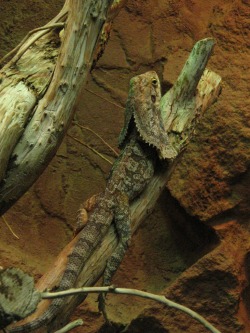
Although not what might be termed an ideal “first lizard”, frilled dragons make fascinating, long-lived additions to the collections of those with a bit of reptile-keeping experience. This week we’ll take a look at how to provide for these unique animals in captivity. Please see Part I of this article for a discussion of their habits in the wild and history in the pet trade.
Space and Other Physical Requirements
Space requirements are probably the main drawback to this species’ suitability as a pet. Males can exceed 3 feet in length, and neither they nor females take well to cramped quarters. Although not particularly active, wild frilled dragons cover large distances in the course of their seasonal movements, traveling from the forest canopy to tree trunks within 15 feet of the ground. They do not actively hunt their prey, but leap to the ground to chase passing insects from their arboreal perches, expending a good deal of energy in the process. Perhaps these lifestyle peculiarities explain in part their need for spacious cages when kept as pets.
Given that frilled dragons are territorial, it is also quite natural that they will instinctively feel stressed without adequate space, even if provided with ample food and protected from competition. Territorial animals almost always need the perception of an adequate space in which to live, despite the fact that their basic needs might, in captivity, be met in a fairly small area. This is an important point to bear in mind when keeping any animal – I have found the principle invaluable in dealing with creatures ranging from tiny insects to large mammals.
Hatchlings can be raised for a time in a 20 gallon aquarium, and a pair of sub-adults can get by in a tank of 55-75 gallon capacity. Adults, however, require a custom or self-built screen cage of at least 3 feet square and 4 feet in height. In all cases, climbing space is more important than floor area.
The cage should be well-stocked with stout, vertically oriented branches, in imitation of the lizards’ natural tree trunk habitat. Be certain that several basking sites are provided if you keep more than 1 animal, and take care to observe that each individual is basking regularly. Dominant animals of either sex may, by their mere presence or actual aggression, prevent others from utilizing the basking sites. The actual perch that is to be used as a basking area should be positioned so that it is an optimal distance (as regards UVB output) from the light source. This distance is less than 12 inches for most fluorescent bulbs (but check manufacturer’s recommendation) and may be greater for certain incandescent UVB emitting models.
Frilled dragons rely largely upon camouflage for protection, and will feel comfortable “hiding” on their perches. However, particularly high-strung individuals should be given the opportunity to shelter beneath artificial plants suspended from the branches. If you are using a screen cage, please bear in mind that one side of the enclosure should be a solid wall, or should be rendered so by a piece of canvas or the like. It is a rare animal that feels at ease when completely exposed on all 4 sides – frilled dragons and other lizards are particularly sensitive in this regard. Again, this is a general principle, applicable across most of the animal kingdom – adhering to it will go a long way in your efforts to habituate wild creatures to captivity (and, ultimately, will contribute to success in breeding efforts).
A mulch-type substrate, such as Keeper’s Choice Tropical Red Cypress Bedding, should cover the cage floor.
Light, Heat and Humidity
Frilled dragons bask frequently, and should have access to a high quality UVB source, such as R Zilla’s 7% Desert UVB Bulb (although not a desert dwelling species, frilled dragons have high UVB requirements) and a full spectrum bulb providing UVA as well. The basking site’s temperature should be 95-100 F, with the rest of the cage maintained in the range of 75-82 F.
Frilled dragons and their cage should be misted with water once or twice daily. Although they often live in habitats devoid of standing water, these lizards will soak and so should be provided with a water bowl.
Feeding
The diet should be as varied as possible – crickets, roaches, waxworms, super mealworms, mealworm beetles and silk worms can form the basis. A pink mouse can be given once every 4-6 weeks, but such is not necessary. Frilled dragons will not thrive on a diet consisting of crickets and super mealworms. Frequent feedings of pink mice or other vertebrates may result in kidney, liver and eye (fatty deposits in the cornea) problems. Field studies have revealed that, while frilled dragons eagerly consume small vertebrates, insects and other invertebrates make up the overwhelming majority of the diet. Their systems are not designed to process a diet rich in mice and other rodents, and, indeed, they get along perfectly well without them in captivity.
Please try to provide wild-caught insects whenever possible. Mine especially favor grasshoppers, katydids, large moths and cicadas. Avoid fireflies, brightly colored insects (due to possible toxicity) and bees, wasps and spiders. Zoo-Med’s Bug Napper is an excellent insect trap, and should be utilized by all serious lizard-keepers.
Some frilled dragons take plant foods, although in my experience they have been few and far between. I suggest trying dandelion flowers, collard, mustard and turnip greens, diced carrot, yam, squash and fruit. Little is known of their preferences for plant foods in the wild.
The food should be powdered with a high quality vitamin/mineral supplement – twice weekly for adults and 4-5 times weekly for hatchlings and gravid females.
Adults can be fed small daily meals, with occasional fast days, or 3-4 times weekly. Hatchlings and growing animals do best when fed 5-7 times per week.
Social Grouping
Hatchlings can be reared together for a time, but hierarchies develop early and smaller animals will not fare well. Males cannot be housed together, but females may co-exist if similarly sized and given adequate space. Watch that all animals are getting enough to eat and are able to bask – even absent outright aggression, subordinate animals may be inhibited by cage-mates.
Captive Longevity
Captive longevity exceeds 15 years; unknown in the wild
Handling and Enrichment
Filled dragons take fairly long in accepting handling, and should be approached with care. While impressive, the flaring of their neck frill is a sign of stress and should not be induced. Even long-term captives react with fear to unexpected movements or noises, and they can administer a painful bite. Well-habituated individuals become quite tame and may be gently handled and hand-fed.
Breeding
Breeding will be covered in greater detail in the future. Frilled dragons may attempt to before fully mature, which leads to egg-retention and other problems. It is safest to keep the sexes separate until maturity is reached.
We have a great deal more to learn about keeping frilled dragons in captivity – your observations, questions and ideas would be much appreciated. Thanks, until next time, Frank.
The abstract to an interesting article on frilled dragons in the wild is posted at:
http://www.jstor.org/pss/1447984
Space and Other Physical Requirements
Space requirements are probably the main drawback to this species’ suitability as a pet. Males can exceed 3 feet in length, and neither they nor females take well to cramped quarters. Although not particularly active, wild frilled dragons cover large distances in the course of their seasonal movements, traveling from the forest canopy to tree trunks within 15 feet of the ground. They do not actively hunt their prey, but leap to the ground to chase passing insects from their arboreal perches, expending a good deal of energy in the process. Perhaps these lifestyle peculiarities explain in part their need for spacious cages when kept as pets.
Given that frilled dragons are territorial, it is also quite natural that they will instinctively feel stressed without adequate space, even if provided with ample food and protected from competition. Territorial animals almost always need the perception of an adequate space in which to live, despite the fact that their basic needs might, in captivity, be met in a fairly small area. This is an important point to bear in mind when keeping any animal – I have found the principle invaluable in dealing with creatures ranging from tiny insects to large mammals.
Hatchlings can be raised for a time in a 20 gallon aquarium, and a pair of sub-adults can get by in a tank of 55-75 gallon capacity. Adults, however, require a custom or self-built screen cage of at least 3 feet square and 4 feet in height. In all cases, climbing space is more important than floor area.
The cage should be well-stocked with stout, vertically oriented branches, in imitation of the lizards’ natural tree trunk habitat. Be certain that several basking sites are provided if you keep more than 1 animal, and take care to observe that each individual is basking regularly. Dominant animals of either sex may, by their mere presence or actual aggression, prevent others from utilizing the basking sites. The actual perch that is to be used as a basking area should be positioned so that it is an optimal distance (as regards UVB output) from the light source. This distance is less than 12 inches for most fluorescent bulbs (but check manufacturer’s recommendation) and may be greater for certain incandescent UVB emitting models.
Frilled dragons rely largely upon camouflage for protection, and will feel comfortable “hiding” on their perches. However, particularly high-strung individuals should be given the opportunity to shelter beneath artificial plants suspended from the branches. If you are using a screen cage, please bear in mind that one side of the enclosure should be a solid wall, or should be rendered so by a piece of canvas or the like. It is a rare animal that feels at ease when completely exposed on all 4 sides – frilled dragons and other lizards are particularly sensitive in this regard. Again, this is a general principle, applicable across most of the animal kingdom – adhering to it will go a long way in your efforts to habituate wild creatures to captivity (and, ultimately, will contribute to success in breeding efforts).
A mulch-type substrate, such as Keeper’s Choice Tropical Red Cypress Bedding, should cover the cage floor.
Light, Heat and Humidity
Frilled dragons bask frequently, and should have access to a high quality UVB source, such as R Zilla’s 7% Desert UVB Bulb (although not a desert dwelling species, frilled dragons have high UVB requirements) and a full spectrum bulb providing UVA as well. The basking site’s temperature should be 95-100 F, with the rest of the cage maintained in the range of 75-82 F.
Frilled dragons and their cage should be misted with water once or twice daily. Although they often live in habitats devoid of standing water, these lizards will soak and so should be provided with a water bowl.
Feeding
The diet should be as varied as possible – crickets, roaches, waxworms, super mealworms, mealworm beetles and silk worms can form the basis. A pink mouse can be given once every 4-6 weeks, but such is not necessary. Frilled dragons will not thrive on a diet consisting of crickets and super mealworms. Frequent feedings of pink mice or other vertebrates may result in kidney, liver and eye (fatty deposits in the cornea) problems. Field studies have revealed that, while frilled dragons eagerly consume small vertebrates, insects and other invertebrates make up the overwhelming majority of the diet. Their systems are not designed to process a diet rich in mice and other rodents, and, indeed, they get along perfectly well without them in captivity.
Please try to provide wild-caught insects whenever possible. Mine especially favor grasshoppers, katydids, large moths and cicadas. Avoid fireflies, brightly colored insects (due to possible toxicity) and bees, wasps and spiders. Zoo-Med’s Bug Napper is an excellent insect trap, and should be utilized by all serious lizard-keepers.
Some frilled dragons take plant foods, although in my experience they have been few and far between. I suggest trying dandelion flowers, collard, mustard and turnip greens, diced carrot, yam, squash and fruit. Little is known of their preferences for plant foods in the wild.
The food should be powdered with a high quality vitamin/mineral supplement – twice weekly for adults and 4-5 times weekly for hatchlings and gravid females.
Adults can be fed small daily meals, with occasional fast days, or 3-4 times weekly. Hatchlings and growing animals do best when fed 5-7 times per week.
Social Grouping
Hatchlings can be reared together for a time, but hierarchies develop early and smaller animals will not fare well. Males cannot be housed together, but females may co-exist if similarly sized and given adequate space. Watch that all animals are getting enough to eat and are able to bask – even absent outright aggression, subordinate animals may be inhibited by cage-mates.
Captive Longevity
Captive longevity exceeds 15 years; unknown in the wild
Handling and Enrichment
Filled dragons take fairly long in accepting handling, and should be approached with care. While impressive, the flaring of their neck frill is a sign of stress and should not be induced. Even long-term captives react with fear to unexpected movements or noises, and they can administer a painful bite. Well-habituated individuals become quite tame and may be gently handled and hand-fed.
Breeding
Breeding will be covered in greater detail in the future. Frilled dragons may attempt to before fully mature, which leads to egg-retention and other problems. It is safest to keep the sexes separate until maturity is reached.
We have a great deal more to learn about keeping frilled dragons in captivity – your observations, questions and ideas would be much appreciated. Thanks, until next time, Frank.
The abstract to an interesting article on frilled dragons in the wild is posted at:
http://www.jstor.org/pss/1447984
BAMBOOZOO NOTE
This subject has many participant comments and I invite you to to read further and participate in the conversation.
http://blogs.thatpetplace.com/thatreptileblog/2008/07/29/the-natural-history-and-captive-care-of-the-frilled-dragon-or-frillneck-lizard-chlamydosaurus-kingii-%e2%80%93-part-i-frilled-dragons-in-the-wild/comment-page-1/#comment-3545
Our appreciation once more for your willingness to share your knowledge!
This subject has many participant comments and I invite you to to read further and participate in the conversation.
http://blogs.thatpetplace.com/thatreptileblog/2008/07/29/the-natural-history-and-captive-care-of-the-frilled-dragon-or-frillneck-lizard-chlamydosaurus-kingii-%e2%80%93-part-i-frilled-dragons-in-the-wild/comment-page-1/#comment-3545
Our appreciation once more for your willingness to share your knowledge!
MY OWN FRILLIE AND HIS ENVIRONMENT ~ BAMBOOZOO
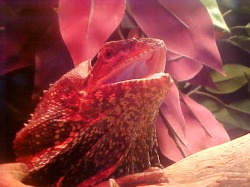
The above article is a very accurate description of my own male Frilled Dragon. Who comes down from the branches and seclution of his favourite spot to bask in the mornings before returning to his hidden branch by mid afternoon. My own lives on a living soil of approximately 5 inches depth with a thriving community of isopods and red wrigglers. My buddy lives with a large local toad of 4 years of age and a wood turtle.
Frilled Dragon Care pdf file: http://nswfmpa.org/Husbandry%20Manuals/Published%20Manuals/Reptilia/Frilled%20Lizard.pdf
Frilled Dragon Care and Forum: http://www.thefrilleddragon.com/content/115-Frilled-Dragon-Care-Sheet
Frilled Dragon Care and Forum: http://www.thefrilleddragon.com/content/115-Frilled-Dragon-Care-Sheet
